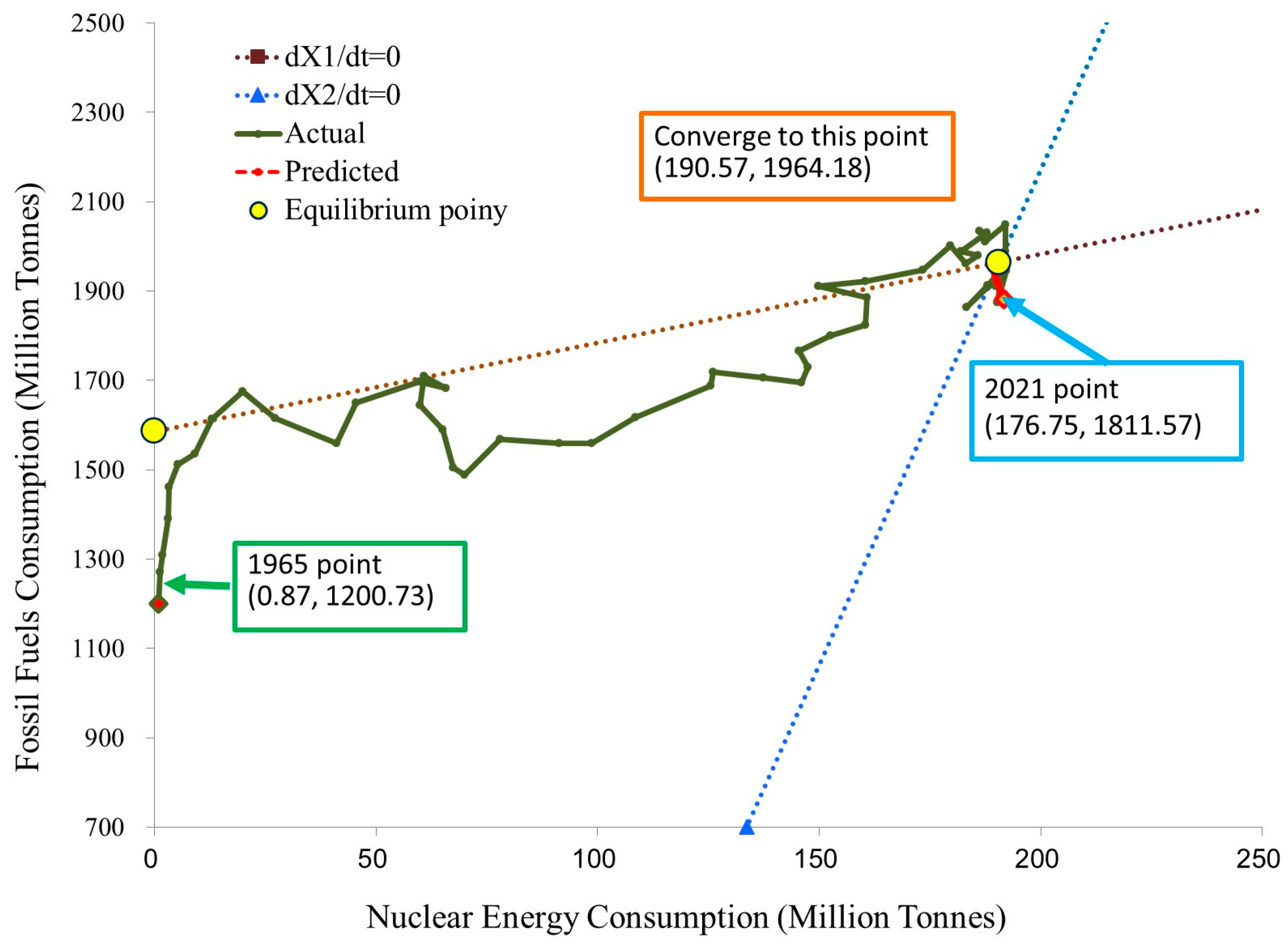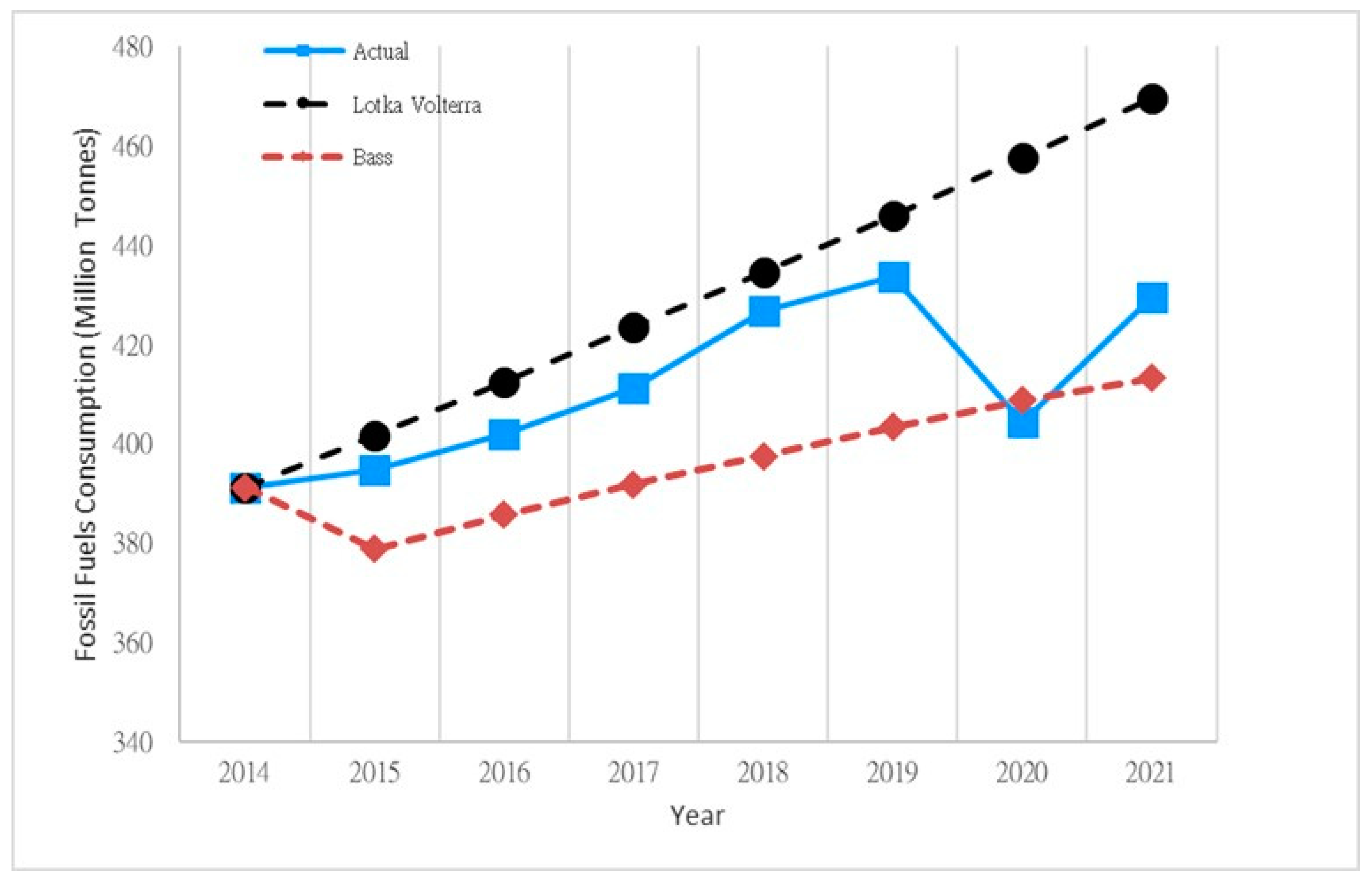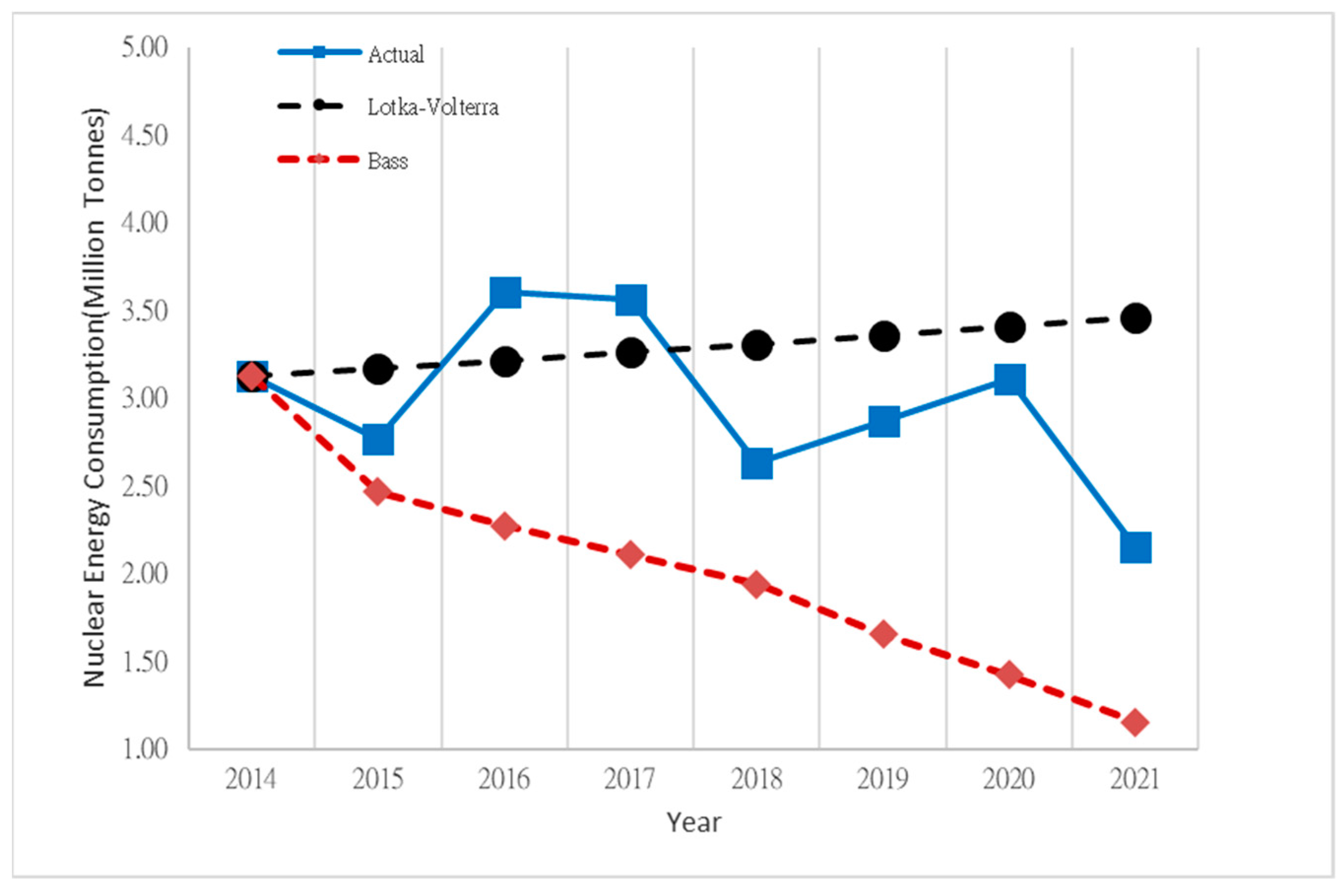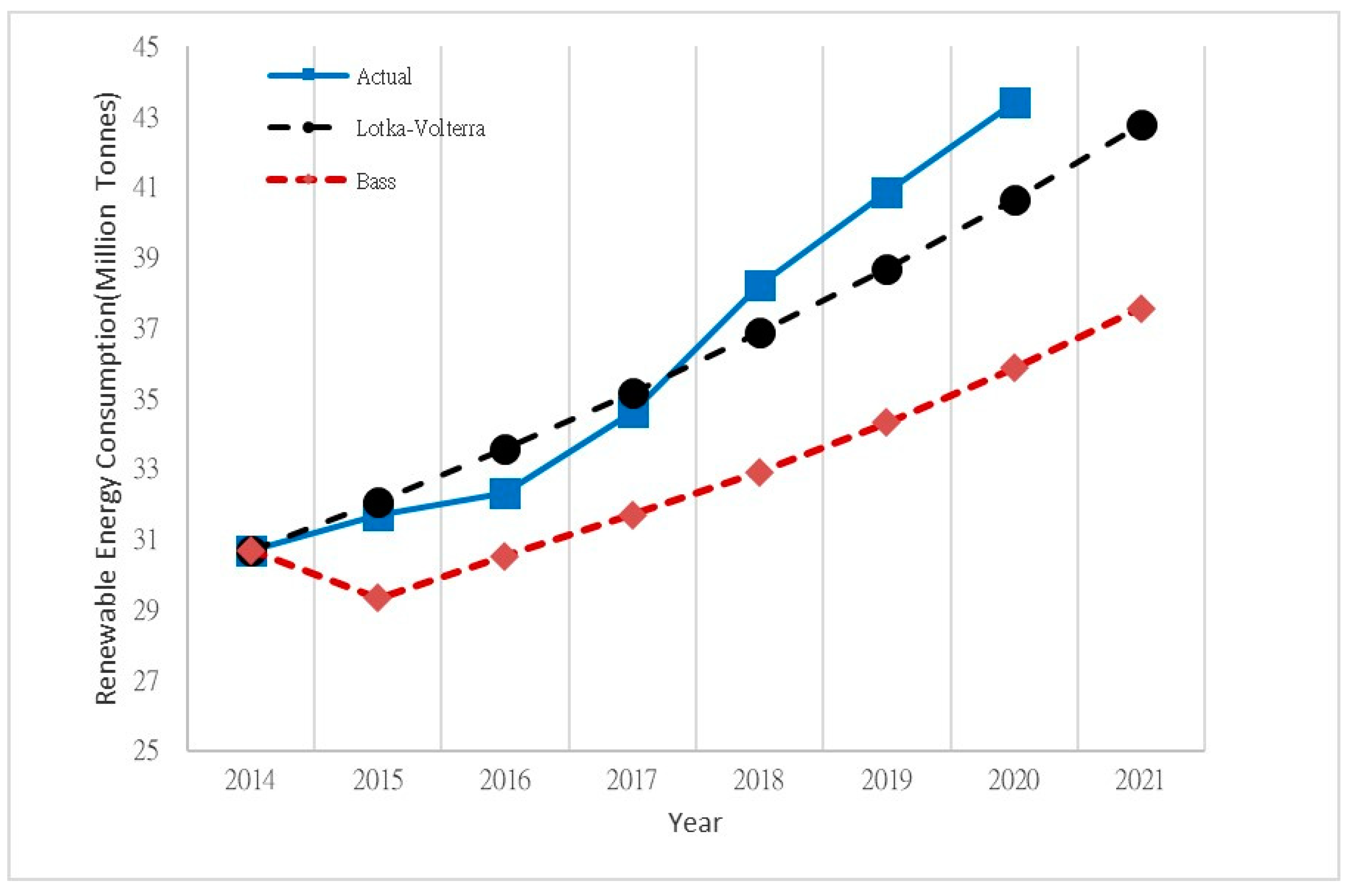Comparing the Substitution of Nuclear Energy or Renewable Energy for Fossil Fuels between the United States and Africa
Abstract
:1. Introduction
2. Methodology
2.1. Lotka–Volterra Model of Energy Consumption
2.2. Equilibrium Stability Analysis
2.3. Predictive Ability Analysis
3. Sample and Data
4. Empirical Results
4.1. Coefficient Estimation Results
4.1.1. Relationships between Fossil Fuels and Nuclear Energy in the United States
4.1.2. Relationships between Fossil Fuels and Renewable Energy in the United States
4.1.3. Relationships between Fossil Fuels and Nuclear Energy in Africa
4.1.4. Relationships between Fossil Fuels and Renewable Energy in Africa
4.2. Equilibrium Analysis Results
4.3. Forecast Accuracy Analysis Results
5. Conclusions
Author Contributions
Funding
Institutional Review Board Statement
Informed Consent Statement
Data Availability Statement
Acknowledgments
Conflicts of Interest
References
- Mahmood, H.; Furqan, M.; Hassan, M.S.; Rej, S. The environmental Kuznets Curve (EKC) hypothesis in China: A review. Sustainability 2023, 15, 6110. [Google Scholar] [CrossRef]
- Halkos, G.; Ekonomou, G. Can business and leisure tourism spending lead to lower environmental degradation levels? Research on the Eurozone economic space. Sustainability 2023, 15, 6063. [Google Scholar] [CrossRef]
- Huang, H.; Ali, S.; Solangi, Y.A. Analysis of the Impact of Economic Policy Uncertainty on Environmental Sustainability in Developed and Developing Economies. Sustainability 2023, 15, 5860. [Google Scholar] [CrossRef]
- Tsai, B.H.; Chang, C.J.; Chang, C.H. Elucidating the consumption and CO2 emissions of fossil fuels and low-carbon energy in the United States using Lotka–Volterra models. Energy 2016, 100, 416–424. [Google Scholar] [CrossRef]
- Friedlingstein, P.; O’sullivan, M.; Jones, M.W.; Andrew, R.M.; Gregor, L.; Hauck, J.; Le Quéré, C.; Luijkx, I.T.; Olsen, A.; Peters, G.P.; et al. Global Carbon Budget 2022. Earth Syst. Sci. Data 2022, 14, 4811–4900. [Google Scholar] [CrossRef]
- Yu, B.L.; Fang, D.B.; Kleit, A.N.; Xiao, K. Exploring the driving mechanism and the evolution of the low-carbon economy transition: Lessons from OECD developed countries. World Econ. 2022, 45, 2766–2795. [Google Scholar] [CrossRef]
- Dong, F.; Bian, Z.F.; Yu, B.L.; Wang, Y.; Zhang, S.N.; Li, J.Y.; Su, B.; Long, R.Y. Can land urbanization help to achieve CO2 intensity reduction target or hinder it? Evidence from China. Resour. Conserv. Recycl. 2018, 134, 206–215. [Google Scholar] [CrossRef]
- Noussan, M.; Roberto, R.; Nastasi, B. Performance Indicators of Electricity Generation at Country Level-The Case of Italy. Energies 2001, 11, 650. [Google Scholar] [CrossRef] [Green Version]
- Yan, Q.; Wang, Y.; Baležentis, T.; Sun, Y.; Streimikiene, D. Energy-Related CO2 Emission in China’s Provincial Thermal Electricity Generation: Driving Factors and Possibilities for Abatement. Energies 2018, 11, 1096. [Google Scholar] [CrossRef] [Green Version]
- Zhao, H.; Huang, G.; Yan, N. Forecasting Energy-Related CO2 Emissions Employing a Novel SSA-LSSVM Model: Considering Structural Factors in China. Energies 2018, 11, 781. [Google Scholar] [CrossRef] [Green Version]
- Dong, Z. A neural-network-based nonlinear adaptive state-observer for pressurized water reactors. Energies 2013, 6, 5382–5401. [Google Scholar] [CrossRef] [Green Version]
- Gao, R.; Nam, H.O.; Ko, W.I.; Jang, H. National Options for a Sustainable Nuclear Energy System: MCDM Evaluation Using an Improved Integrated Weighting Approach. Energies 2017, 10, 2017. [Google Scholar] [CrossRef] [Green Version]
- Lang, P.A. Nuclear Power Learning and Deployment Rates; Disruption and Global Benefits Forgone. Energies 2017, 10, 2169. [Google Scholar] [CrossRef] [Green Version]
- Pan, Y.L.; Dong, F. Factor substitution and development path of the new energy market in the BRICS countries under carbon neutrality: Inspirations from developed European countries. Appl. Energy 2023, 331, 120442. [Google Scholar] [CrossRef]
- Chen, C.C.; Pao, H.T. The causal link between circular economy and economic growth in EU-25. Environ. Sci. Pollut. Res. 2022, 29, 76352–76364. [Google Scholar] [CrossRef]
- Pao, H.T.; Chen, C.C. The dynamic interaction between circular economy and the environment: Evidence on EU countries. Waste Manag. Res. 2022, 40, 969–979. [Google Scholar] [CrossRef]
- Nguyen, X.P.; Le, N.D.; Pham, V.V.; Huynh, T.T.; Dong, V.H.; Hoang, A.T. Mission, challenges, and prospects of renewable energy development in Vietnam. Energy Sources Part A Recov. Util. Environ. Eff. 2021, 1–13. [Google Scholar] [CrossRef]
- Hoang, A.T.; Nizetic, S.; Olcer, A.I.; Ong, H.C.; Chen, W.H.; Chong, C.T.; Thomas, S.; Bandh, S.A.; Nguyen, X.P. Impacts of COVID-19 pandemic on the global energy system and the shift progress to renewable energy: Opportunities, challenges, and policy implications. Energy Policy 2021, 154, 112322. [Google Scholar] [CrossRef]
- Gao, R.G.; Jiang, J.J. Design and implementation of environmental design based on new energy technology. Energy Rep. 2022, 8, 7600–7611. [Google Scholar] [CrossRef]
- Firmansyah, H.; Tan, Y.; Yan, J. Power and methanol production from biomass combined with solar and wind energy: Analysis and comparison. Energy Procedia 2018, 145, 576–581. [Google Scholar] [CrossRef]
- Jewell, J. Ready for nuclear energy?: An assessment of capacities and motivations for launching new national nuclear power programs. Energy Policy 2011, 39, 1041–1055. [Google Scholar] [CrossRef]
- Pan, Y.L.; Dong, F. Dynamic evolution and driving factors of new energy development: Fresh evidence from China. Technol. Forecast. Soc. Change 2022, 176, 121475. [Google Scholar] [CrossRef]
- U.S. EIA. Nuclear Regulatory Commission. 2012. Available online: https://www.eia.gov/energyexplained/nuclear/nuclear-power-and-the-environment.php (accessed on 22 January 2023).
- Kieckh Fer, K.; Quante, G.; Müller, C.; Spengler, T.S.; Lossau, M.; Jonas, W. Simulation-Based Analysis of the Potential of Alternative Fuels towards Reducing CO2 Emissions from Aviation. Energies 2018, 11, 186. [Google Scholar] [CrossRef] [Green Version]
- Simon, S.; Naegler, T.; Gils, H.C. Transformation towards a Renewable Energy System in Brazil and Mexico—Technological and Structural Options for Latin America. Energies 2018, 11, 907. [Google Scholar] [CrossRef] [Green Version]
- Lenzen, M. Life cycle energy and greenhouse gas emissions of nuclear energy: A review. Energy Convers. Manag. 2008, 49, 2178–2199. [Google Scholar] [CrossRef]
- Sovacool, B.K. Valuing the greenhouse gas emissions from nuclear power: A critical survey. Energy Policy 2008, 36, 2950–2963. [Google Scholar] [CrossRef]
- Van Leeuwen, J.W.S.; Smith, P. Nuclear Power: The Energy Balance; Springer: Cham, Switzerland, 2005; pp. 1–24. [Google Scholar]
- Torfs, R.; Huybrechts, D.; Wouters, G. Broeikasgasemissies, Verzurende Emissies en Energiegebruik van Energiedragers Vanaf de Ontginning tot Aan de Eindgebruiker; Flemish Institute for Technological Researc (VITO): Brussels, Belgium, 1998. [Google Scholar]
- Chang, H.Y.; Chen, R.H.; Lai, C.M. Numerical simulation of the thermal performance of a dry storage cask for spent nuclear fuel. Energies 2018, 11, 149. [Google Scholar] [CrossRef] [Green Version]
- Ligus, M. Evaluation of Economic, Social and Environmental Effects of Low-Emission Energy Technologies Development in Poland: A Multi-Criteria Analysis with Application of a Fuzzy Analytic Hierarchy Process (FAHP). Energies 2017, 10, 1550. [Google Scholar] [CrossRef] [Green Version]
- RodriGuez-Penalonga, L.; Soria, B.Y.M. A review of the nuclear fuel cycle strategies and the spent nuclear fuel management technologies. Energies 2017, 10, 1235. [Google Scholar] [CrossRef] [Green Version]
- Bowen, R.M.; Castanias, R.P.; Daley, L.A. Intra-industry effects of the accident at Three Mile Island. J. Financ. Quant. Anal. 1983, 18, 87–111. [Google Scholar] [CrossRef]
- Fields, M.A.; Janjigian, V. The effect of Chernobyl on electric-utility stock prices. J. Bus. Res. 1989, 18, 81–87. [Google Scholar] [CrossRef]
- Betzer, A.; Doumet, M.; Rinne, U. How policy changes affect shareholder wealth: The case of the Fukushima Dai-ichi nuclear disaster. Appl. Econ. Lett. 2013, 20, 799–803. [Google Scholar] [CrossRef] [Green Version]
- Ferstl, R.; Utz, S.; Wimmer, M. The effect of the Japan 2011 disaster on nuclear and alternative energy stocks worldwide: An event study. Bus. Res. 2012, 5, 25–41. [Google Scholar] [CrossRef] [Green Version]
- Fan, Z.P.; Che, Y.J.; Chen, Z.Y. Product sales forecasting using online reviews and historical sales data: A method combining the Bass model and sentiment analysis. J. Bus. Res. 2017, 74, 90–100. [Google Scholar] [CrossRef]
- Lee, C.Y.; Lee, M.K. Demand Forecasting in the Early Stage of the Technology’s Life Cycle Using a Bayesian Update. Sustainability 2017, 9, 1378. [Google Scholar] [CrossRef] [Green Version]
- Tsai, B.H. Modeling diffusion of multi-generational LCD TVs while considering generation-specific price effects and consumer behaviors. Technovation 2013, 33, 345–354. [Google Scholar] [CrossRef]
- Lin, C.S. Forecasting and analyzing the competitive diffusion of mobile cellular broadband and fixed broadband in Taiwan with limited historical data. Econ. Model. 2013, 35, 207–213. [Google Scholar] [CrossRef] [Green Version]
- Tsai, B.H. Modelling Energy Consumption and Carbon Dioxide Emissions of Fossil Fuels and Nuclear Energy using Lotka-Volterra Equations. Appl. Ecol. Environ. Res. 2022, 20, 1435–1455. [Google Scholar] [CrossRef]
- Tsai, B.H.; Hsu, C.S.; Balachandran, B.K. Modeling competition between mobile and desktop personal computer LCD panels based on segment reporting sales information. J. Acc. Audit. Finance 2013, 28, 273–291. [Google Scholar] [CrossRef]
- Bass, F.M. A new product growth for model consumer durables. Manag. Sci. 1969, 15, 215–227. [Google Scholar] [CrossRef]
- Martin, C.A.; Witt, S.F. Accuracy of econometric forecasts of tourism. Ann. Tour. Res. 1989, 16, 407–428. [Google Scholar] [CrossRef]
- Hritonenko, N.; Yatsenko, Y. Mathematical Modeling in Economics, Ecology and the Environment; Springer: New York, NY, USA, 1999. [Google Scholar]








| Pair one | Fossil | Nuclear | |||
| Coefficient | t-Statistic | Coefficient | t-Statistic | ||
| α1 | 1.243940 | 13.313824 *** | α2 | 1.105225 | 8.284798 *** |
| β1 | 0.000154 | 2.415522 ** | β2 | 0.001030 | 3.844238 ** |
| γ1 | −0.000306 | −1.696481 * | γ2 | −0.000046 | −0.554438 * |
| Adjusted R2 | 0.950505 | Adjusted R2 | 0.994220 | ||
| Pair two | Fossil | Renewable | |||
| Coefficient | t-Statistic | Coefficient | t-Statistic | ||
| α1 | 1.108970 | 26.972427 *** | α2 | 0.979189 | 8.450911 *** |
| β1 | 0.000067 | 2.389635 ** | β2 | 0.000882 | 0.948305 |
| γ1 | −0.000225 | −0.654088 | γ2 | −0.000062 | −0.837827 |
| Adjusted R2 | 0.947048 | Adjusted R2 | 0.799433 | ||
| Pair one | Pair two | ||||
| Fossil | Nuclear | Fossil | Renewable | ||
| ai | 0.218284 | 0.100049 | 0.103432 | −0.021030 | |
| bi | 0.000138 | 0.000980 | 0.000064 | 0.000891 | |
| ci | −0.000274 | −0.000044 | −0.000213 | −0.000063 | |
| Pair one | Fossil | Nuclear | |||
| Coefficient | t-Statistic | Coefficient | t-Statistic | ||
| α1 | 1.051173 | 89.372333 *** | α2 | 1.630882 | 6.406432 *** |
| β1 | −0.000046 | −0.674886 | β2 | 0.416840 | 3.213824 *** |
| γ1 | 0.013378 | 2.246280 ** | γ2 | −0.001775 | −2.524072 ** |
| Adjusted R2 | 0.997634 | Adjusted R2 | 0.952987 | ||
| Pair two | Fossil | Renewable | |||
| Coefficient | t-Statistic | Coefficient | t-Statistic | ||
| α1 | 1.068860 | 87.860238 *** | α2 | 1.023909 | 51.700878 *** |
| β1 | 0.000725 | 3.641271 *** | β2 | 0.000270 | 0.061292 |
| γ1 | −0.008547 | −3.312911 *** | γ2 | −0.000074 | −0.223302 |
| Adjusted R2 | 0.997888 | Adjusted R2 | 0.992614 | ||
| Pair one | Pair two | ||||
| Fossil | Nuclear | Fossil | Renewable | ||
| ai | 0.049907 | 0.489121 | 0.066593 | 0.023628 | |
| bi | −0.000045 | 0.323175 | 0.000701 | 0.000266 | |
| ci | 0.013047 | −0.001376 | −0.008266 | −0.000073 | |
| United States | Africa | |||
|---|---|---|---|---|
| Lotka–Volterra | Bass | Lotka–Volterra | Bass | |
| Pair one | ||||
| Fossil Fuels | 5.75% | 8.33% | 4.92% | 4.66% |
| Nuclear Energy | 3.70% | 22.53% | 21.02% | 42.27% |
| Pair two | ||||
| Fossil Fuels | 6.95% | 8.33% | 12.92% | 4.66% |
| Renewable Energy | 25.73% | 27.11% | 4.04% | 16.24% |
Disclaimer/Publisher’s Note: The statements, opinions and data contained in all publications are solely those of the individual author(s) and contributor(s) and not of MDPI and/or the editor(s). MDPI and/or the editor(s) disclaim responsibility for any injury to people or property resulting from any ideas, methods, instructions or products referred to in the content. |
© 2023 by the authors. Licensee MDPI, Basel, Switzerland. This article is an open access article distributed under the terms and conditions of the Creative Commons Attribution (CC BY) license (https://creativecommons.org/licenses/by/4.0/).
Share and Cite
Tsai, B.-H.; Huang, Y.-M. Comparing the Substitution of Nuclear Energy or Renewable Energy for Fossil Fuels between the United States and Africa. Sustainability 2023, 15, 10076. https://doi.org/10.3390/su151310076
Tsai B-H, Huang Y-M. Comparing the Substitution of Nuclear Energy or Renewable Energy for Fossil Fuels between the United States and Africa. Sustainability. 2023; 15(13):10076. https://doi.org/10.3390/su151310076
Chicago/Turabian StyleTsai, Bi-Huei, and Yao-Min Huang. 2023. "Comparing the Substitution of Nuclear Energy or Renewable Energy for Fossil Fuels between the United States and Africa" Sustainability 15, no. 13: 10076. https://doi.org/10.3390/su151310076
APA StyleTsai, B.-H., & Huang, Y.-M. (2023). Comparing the Substitution of Nuclear Energy or Renewable Energy for Fossil Fuels between the United States and Africa. Sustainability, 15(13), 10076. https://doi.org/10.3390/su151310076




